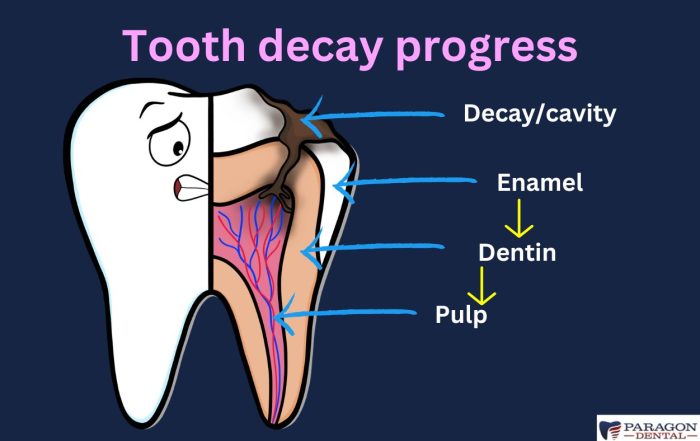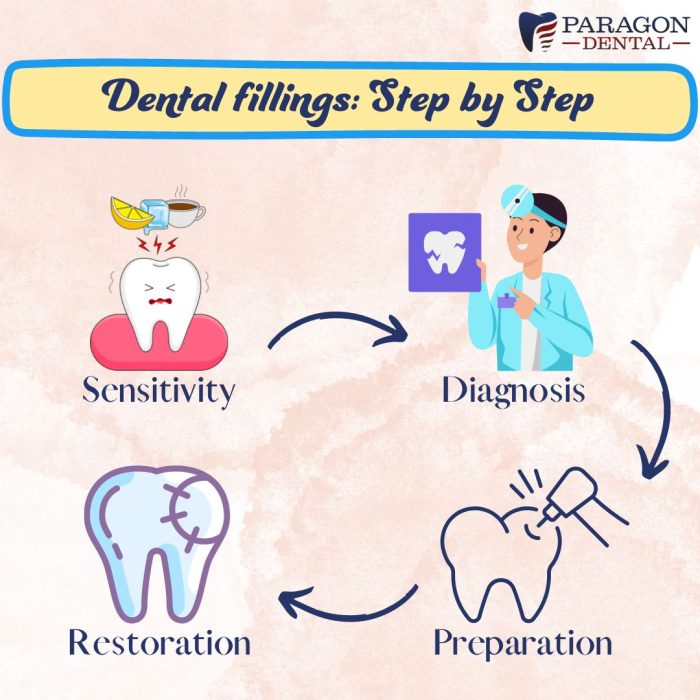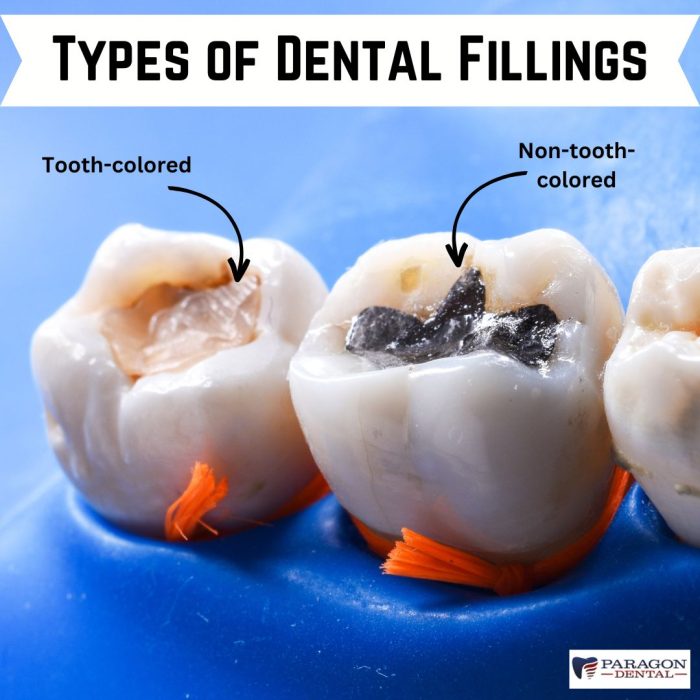
Filling Up on Knowledge: Exploring the Different Types of Dental Fillings
Contents:
- Introduction
- Cavities: Understanding the Why and How
- Types of dental fillings
Tooth-colored
Non-tooth-colored - Aftercare
- Conclusion
Introduction
Has your dentist told you that you need a dental filling? Perhaps you noticed food getting stuck in your tooth, a change in color on your tooth, or a little sensitivity. Your dentist has checked and recommended a filling to address these issues.
It’s a common procedure, but with so many different types of dental fillings out there, it can be overwhelming to choose the right one. Don’t worry; we’ve got you covered!
In this blog, we’ll be taking a deep dive into the world of dental fillings. We’ll discuss the pros and cons of each filling to help you make an informed decision about your oral health. So, sit back, relax, and get ready to fill up on knowledge!
Cavities: Understanding the Why and How
So why do cavities happen in the first place? When you eat food rich in carbohydrates, commonly known as starch, the bacteria in your mouth produce acid that can harm your teeth. This acid attacks the enamel, which is the outer white layer of your teeth, that we see in our mouth, and can cause decay or cavities to form.

The decay usually begins on the chewing surfaces of your teeth or in between your teeth, where food particles and bacteria are not easily washed off.
Over time, if the decay is not treated, it can progress deeper into the tooth and affect the inner layers of the tooth (dentin and pulp). This can cause pain, sensitivity, and infection. If left untreated, the decay can even lead to the loss of the tooth.
To prevent this from happening, your dentist may recommend a dental filling, also known as dental restoration. During the filling procedure, the decayed portion of the tooth is removed and replaced with a filling material. This material helps to restore the tooth’s structure and function and prevent further decay.

Types of dental fillings:
There are two types of dental fillings: tooth-colored fillings and non-tooth-colored fillings.

Tooth-colored fillings:
They include permanent fillings: Composite and Ceramics
and temporary filling: GIC
1. Composite:
Composite fillings are a popular choice for two reasons:
- They have the ability to match the color of your natural teeth.
- They offer high strength
Hence, they are perfect for filling cavities in your back teeth, molars and premolars, where high strength is required, and your front teeth, where aesthetics are just as important.
Composite fillings stick directly to the tooth, which means that they don’t require extra removal of healthy tooth material to stay in place. This helps to preserve the strength and integrity of the tooth.
Silver fillings require extra tooth removal sometimes because it needs bulk to resist fracturing. Also, as silver fillings don’t stick to the tooth, this can sometimes require the removal of healthy tooth material in order to create a shape that can hold the filling securely.
Although time taking, composite fillings can often be completed in a single dental visit. Hence it is more convenient for patients with busy schedules or limited availability.
A disadvantage is that composite fillings can become stained over time due to factors such as the consumption of coffee, tea, wine, and other foods and beverages that can cause discoloration.
2. Ceramic inlay/onlay:
If your tooth has lost a significant amount of its structure, then your dentist may recommend inlays or onlays. They provide a strong and long-lasting solution (up to 15 years) for teeth with extensive damage or decay.
However, they require at least two visits to the dental clinic.
During your first visit, your dentist will remove the decayed portion of your tooth and take an impression to send it to the lab.
Then the fillings are custom-made in a dental lab.
During your second visit to the clinic, the filling will be bonded to your prepared tooth.
Although they are a more time-consuming and expensive option, they can provide a durable solution for your damaged tooth.
3. Glass Ionomer Cement (GIC):
Although they are tooth-colored fillings, they are not as strong as composites to withstand the high chewing forces in your back teeth for a long period of time.
They are used as a temporary solution while waiting to see if the tooth will require root canal treatment or can be restored with a more permanent filling material such as composite or amalgam.
It is also done in places where the chewing forces are not high, like the part of your tooth near the gums.
GIC is usually done in children, as their milk teeth will eventually fall out and be replaced by permanent teeth.
Another reason for using them in children is that they release fluoride, which helps the tooth gain more resistance against the acid produced by bacteria in the mouth. Hence GIC helps prevent further decay in the tooth.
Non-tooth-colored Fillings:
Non-tooth-colored fillings were commonly used in the past, such as gold and silver amalgam. With advancements in dental technology, tooth-colored options have become more popular.
However, in some cases, such as in back teeth with high chewing forces or for patients with limited access to dental care, silver fillings may still be used as a practical and cost-effective option.
Silver filling:
Silver filling, also known as amalgam, has been used in dentistry for over 150 years due to its strength and durability, making them a popular choice for back teeth that endure a lot of chewing force.
However, their dark color makes them less aesthetically pleasing.
Some people are also concerned about the use of mercury in amalgam fillings, as it can potentially release mercury vapor over time.
Although studies have not shown any harmful effects, some individuals prefer to avoid these fillings for this reason.
Additionally, they do not bond with the tooth and rely on mechanical features to stay in place, sometimes resulting in more tooth removal than necessary, weakening the tooth and making it more prone to fractures over time.
Aftercare:
After getting a dental filling, it’s important to take good care of your teeth to ensure the filling lasts a long time and to prevent any further decay or damage. Here are some tips for aftercare:
- Avoid eating or drinking anything for at least one hour after the procedure. This will allow the filling to set properly.*In case of silver filling, it’s important to avoid chewing hard or crunchy foods for at least 24 hours after the procedure.
- Take pain relievers as recommended by your dentist. Over-the-counter pain relievers such as ibuprofen or acetaminophen can help reduce any discomfort.
- Keep up with regular dental checkups and cleanings to ensure the filling remains in good condition.
- If you notice any problems with the filling, such as pain or sensitivity, or if the filling falls out, contact your dentist as soon as possible to have it evaluated and repaired.
Conclusion:
In conclusion, there are various types of dental restorative materials available, each with its own advantages and disadvantages. Ultimately, the choice of material will depend on the patient’s individual needs, preferences, and budget, as well as the dentist’s recommendation.
With proper oral hygiene and regular dental check-ups, your fillings can last for many years and help to protect your teeth from further decay.
Please note that experiencing pain from hot foods and beverages can be a sign of a more serious dental issue. Consult a dentist who can properly diagnose and recommend the appropriate treatment, which may include a root canal treatment (RCT).
It’s important to follow your dentist’s recommendation and get the appropriate treatment to prevent further damage and ensure your oral health.
Need to discuss which option is right for you?
Call us now for an appointment at (209) 548-0100, or come by our clinic at Paragon Dental, 1108 Oakdale Road, Suite A, Modesto, California 95355, to get the dental care that you need.
At Paragon Dental, we strive to provide high-quality dental care to our patients. If you’re experiencing any dental issues, don’t hesitate to schedule an appointment with us.
Contact us today to book your appointment and take the first step towards a healthier smile.

